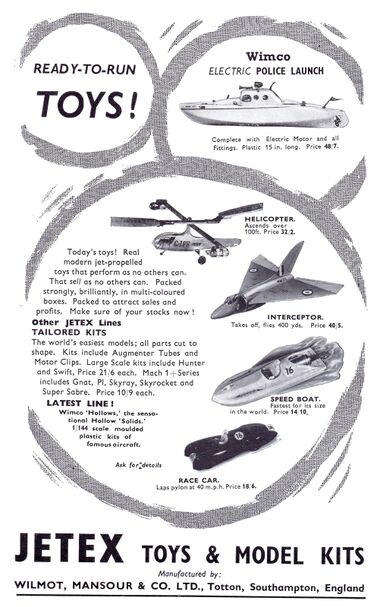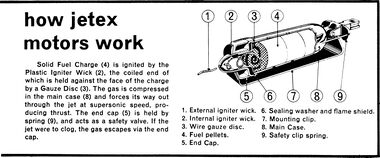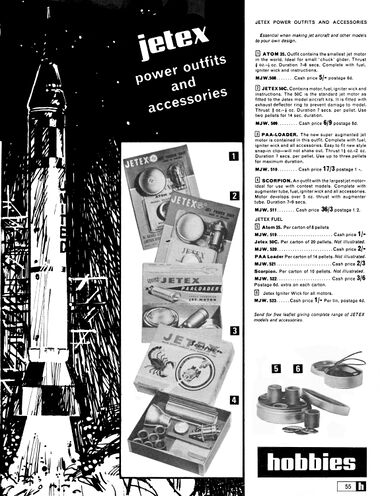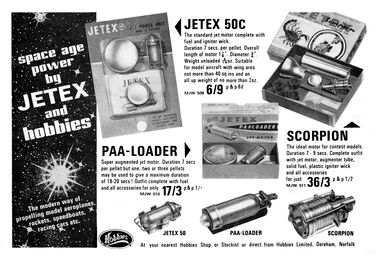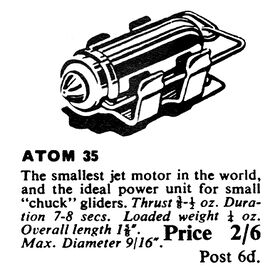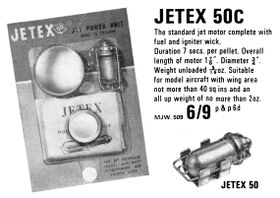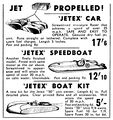Category:Jetex rocket motors
| Toy Brands and Manufacturers |
|---|
Jetex rocket motors |
| 1948 - |
1956: Jetex and Wimco ready-to-run models. The launch top right is not part of the Jetex range [image info]
1966: Jetex Kits and Power Kits, Hobbies Annual [image info]
1966: Jetex Type 50C [image info]
"How Jetex Motors Work" [image info]
1967: Jetex rocket engines and accessories [image info]
1967: "Space age power by Jetex and Hobbies" [image info]
1969/1970: "JETEX" article by Ernie Webster, KeilKraft Handbook [image info]
Jetex reusable rocket motors (by Wilmot, Mansour & Co., Ltd., 1948-) were designed for model aircraft, but were sometimes also fitted to model cars and other model vehicles.
Origins
Joseph "Joe" Mansour and brothers John Wilmot and Charles Wilmot (known as "Bill") had been enthusiastic model aircraft builders, and had together started International Model Aircraft, with backing from Lines Brothers to create the Tri-ang FROG ("Flies Right Off Ground") model aircraft brand. During the war, IMA had produced drones for target practice for the military, and had upgraded the drones with small rocket boosters. With the ability of the Ministry of Defence to get scientists and engineers form different fields working together, ICI were tasked with producing a more convenient rocket fuel for the target drone boosters, and after John died in 1943 and Bill and Joe left IMA, the two remaining members of the original team decided to further refine and commercialise the rocket boosters for the model aircraft market.
The new product was launched with the June 1948 issue of Aeromodeller magazine, showing a painting of a yellow/orange airborne jet-engined Gloster Meteor on the cover, which, on closer inspection, turns out to be a duplicate of a radio-controlled model pictured on the ground below, with owners. To the model aeroplane community, a cover image of a radio controlled aeroplane with no propellers must have been shocking and intriguing.
Wilmot and Mansour initially only produced the engines (perhaps because they didn't initially have the time to also design and put into production actual planes, and perhaps because of not wanting to immediately go into head-on competition with their previous company, which was backed by the giant Lines Brothers empire). As a result, initial Jetex-powered model aircraft were produced and sold independently by other companies, who were probably pleased to be able to concentrate on just making the aircraft models and having Jetex supply the standardised ready-made power plants. Later, with the acquisition of a further ex-IMA designer or two, Jetex started producing their own range of model aircraft, cars and boats.
Characteristics
The popularity of the Jetex system in the 1950s was due to how well the system had been thought out. The propellant (guanidine nitrate) was comparatively slow-burn, with a comparatively cool exhaust and a decent burn time, which meant that a model aircraft didn't have to deal with severe stresses or have to have extravagant fireproofing, and the reusable shell could be made of aluminium or aluminium alloy with a lower melting point. The casing design included a sprung safety release valve so that the rocket wasn't prone to exploding if something went wrong, and the fuelling process involved placing a spiral coil of fuse against the pellet's flat face, held in place by metal gauze, producing a guaranteed consistent burn and removing another possible cause of unreliability. The metal gauze sheet was a fixed distance from the exhaust, which meant that there was a guaranteed length of fuse "tail" between the gauze and the lighting-point, and a minimum time delay between lighting the fuse and the fuel igniting – unless the user rammed a lit object inside the actual engine, it was pretty much impossible to accidentally light the fuel directly.
The manufacturers also made of point of mentioning that the guanidine nitrate propellant was supplied to them by ICI (who seem to have been a co-patenter), eliminating the worry of small-batch production producing variations in performance.
Overall, the Jetex system was easy to use, reliable, and comparatively safe, and its predictability meant that makers were confident about making model vehicles (even cars!) that could be sold as "Jetex-compatible" – knowing that the behaviour of the customer's unit would be pretty much the same the same as that of their test model.
Licensing
Jetex motors were also made under licence in France by Solido, and advertised in the French edition of Meccano Magazine during Summer 1955.
Les Avions à Réaction JETEX réalisant sans aucune complication des vols impeccables qui vous étonneront.
JETEX Brevet mondial, combustible solide, innofensiv.
JETEX Jouets & Moteurs à Réaction Fabriques en France sous licence par Solido
— , -, , Meccano Magazine Francais, , May, June, July, August 1955
1952 article excerpt:
The tiny aluminium motor burns pellets of solid fuel. So the fuel won't go up all at once like a firecracker, it is especially treated to burn quite slowly. The Jetex unit holds a single pellet of fuel, which takes about ten to twelve seconds to burn. Sounds like a short time, but this is a fast plane and will get high in the air with this length of power run. The Jetex motor comes packed with complete instructions for use, so we won;t go into it here. But READ the instructions before you try a power flight.
— , Howard G McEntre, , A Jet-Propelled Delta Plane, , Boy's Life, , September 1957
1967 promotional text:
How Jetex motors work
Solid Fuel Charge (4) is ignited by the Plastic Igniter Wick (2), the coiled end of which is held against the face of the charge by a Gauze Disc (3) The gas is compressed in the main case (8) and forces its way out through the jet at supersonic speed, producing thrust. The end cap (5) is held by spring (9), and acts as a safety valve. If the jet were to clog, the gas escapes via the end cap.
Rocket Motors
Jetex Atom 35 [image info]
ATOM 35
The smallest jet motor in the world, and the ideal power unit for small "chuck" gliders. Thrust 3⁄8-1⁄2 oz. Overall length 1 5⁄8. Max diameter 9⁄16
Jetex 50C [image info]
JETEX 50C
The standard jet motor complete with fuel and igniter wick.
Duration 7 secs per pellet. Overall length of motor 1 7⁄8". Diameter 3⁄4". Weight unloaded 5⁄16 oz. Suitable for model aircraft with wing area not more than 40 square inches and an all-up weight of no more than 2 oz.
Jetex PAA-LOADER [image info]
PAA-LOADER
Super augmented jet motor. Duration 7 secs per pellet but one, two or three pellets may be used to give a maximum duration of 18-20 seconds! Outfit complete with fuel and all accessories for only 17/3
Jetex Scorpion [image info]
SCORPION
The ideal motor for contest models. Duration 7-9 seconds. Complete outfit with jet motor, augmenter tube, solid fuel, plastic igniter wick and all accessories for just 36/3
The use of an augmenter tube (basically a long tailpipe) was supposed to increase thrust, but for model aircraft designs also had the advantage that one could place the engine forwards or centrally (for balanced weight), but have the exhaust jet emerging near the back of the plane, rather than have it potentially playing along the body of the aircraft and setting the tail on fire.
Patent
The Jetex concept seem to have been patented in 1950 (submitted in March 1948) by an A. C. Hutchinson, M. Wilson, and ICI Ltd., patent number GB645897.
"Rapier" rockets
More recently, a range of rocket thrusters for model aircraft with broadly similar characteristics – the "Rapier" range – has started being produced in the Czech Republic. These are one-shot rockets with a cardboard casing.
Addresses
- Wilmot, Mansour & Co., Ltd., Totton, Southampton, England
External links
- Jetex.org community fan site (jetex.org)
- Welcome to Mike's flying scale model pages: Jetex/Rapier powered models (ffscale.co.uk)
- JETEX POWERED MODELS (vintagemodelcompany.com)
- Society of Antique Modellers: SAM35 index: Articles related to Jetex and equivalents (sam35.org.uk)
- Fun with Jetex Engines (nadmes.org.uk)
- Jetex/Solido advert, Meccano Magazine Francais, May 1955 (meccanoindex.co.uk)
patent:
Subcategories
This category has the following 3 subcategories, out of 3 total.
Pages in category ‘Jetex rocket motors’
This category contains only the following page.
Media in category ‘Jetex rocket motors’
The following 52 files are in this category, out of 52 total.
- Atom 35 rocket motor, Jetex (Hobbies 1966).jpg 1,046 × 1,014; 336 KB
- Avro 707A Delta, for Jetex 50, KeilKraft (KeilKraft 1969).jpg 2,200 × 1,418; 340 KB
- DeHavilland Venom, for Jetex 50, KeilKraft (KeilKraft 1969).jpg 2,200 × 1,180; 427 KB
- DH 110 Sea Vixen, for Jetex 50, KeilKraft (KeilKraft 1969).jpg 2,200 × 1,328; 323 KB
- Douglas F4D Skyray, for Jetex 50, KeilKraft (KeilKraft 1969).jpg 2,200 × 1,241; 375 KB
- Eagle Book of Spacecraft Models (Hobbies 1968).jpg 1,802 × 1,721; 981 KB
- Gloster Javelin model aircraft, Jetex 50C (Hobbies 1966).jpg 2,175 × 1,639; 745 KB
- Gloster Javelin, for Jetex 50, KeilKraft (KeilKraft 1969).jpg 2,200 × 1,397; 578 KB
- Gnat Glider, for Jetex, cover image crop (KeilKraft 1969).jpg 1,200 × 566; 576 KB
- Grumman Panther, for Jetex 50, KeilKraft (KeilKraft 1969).jpg 2,200 × 1,273; 381 KB
- Hawker Hunter, for Jetex 50, KeilKraft (KeilKraft 1969).jpg 2,200 × 1,274; 436 KB
- Helicopter, Jetex (BPO 1955-10).jpg 1,230 × 689; 163 KB
- How Jetex Motors Work (Hobbies 1967).jpg 3,000 × 1,245; 932 KB
- Interceptor aircraft, Jetex (BPO 1955-10).jpg 1,144 × 753; 183 KB
- Javelin aeroplane, Jetex (Hobbies 1967).jpg 1,549 × 1,316; 445 KB
- Jet Car, Jetex (Hobbies 1967).jpg 1,927 × 1,385; 557 KB
- Jet Hydroplane, Jetex (Hobbies 1967).jpg 1,851 × 1,138; 531 KB
- Jetex 50 Motor (KeilKraft 1969).jpg 911 × 1,200; 251 KB
- Jetex 50c rocket motor (MM 1967-07).jpg 2,277 × 1,607; 1.16 MB
- Jetex advert, Hobbies (MM 1967-07).jpg 3,000 × 2,033; 2.55 MB
- Jetex Car and Boat, Gamages (MM 1950-11).jpg 2,197 × 673; 474 KB
- Jetex Cars and Boats, Gamages (MM 1950-08).jpg 2,828 × 3,000; 1.9 MB
- Jetex F-102 aircraft, advert (USA 1954).jpg 844 × 1,200; 324 KB
- Jetex Kits and Power Kits (Hobbies 1966).jpg 860 × 1,200; 975 KB
- Jetex Models (Hobbies 1967).jpg 3,000 × 1,028; 1.02 MB
- Jetex Power and Accessories (Hobbies 1967).jpg 2,297 × 3,000; 2.37 MB
- Jetex rocket motor, cross-section diagram (Hobbies 1967).jpg 1,728 × 1,264; 445 KB
- Jetex toys and model kits (GaT 1956).jpg 1,001 × 1,600; 296 KB
- Jetex Type 50C rocket motor(Hobbies 1966).jpg 1,767 × 1,249; 688 KB
- KeilKraft for Jetex 50 Motors (KeilKraft 1969).jpg 1,024 × 767; 110 KB
- KeilKraft Jetex-powered Flying Saucer (HH 1952).jpg 892 × 668; 152 KB
- KeilKraft Jetex-powered range (HH 1952).jpg 800 × 163; 23 KB
- MIG 15, for Jetex 50, KeilKraft (KeilKraft 1969).jpg 2,200 × 1,133; 337 KB
- Model Racing Car, Jetex, Selfridges (MM 1949-08).jpg 1,643 × 2,200; 926 KB
- North American F-86 Sabre, for Jetex 50, KeilKraft (KeilKraft 1969).jpg 2,200 × 1,118; 390 KB
- PAA-Loader, Jetex (MM 1967-07).jpg 2,620 × 1,320; 1.13 MB
- Race Car, Jetex (BPO 1955-10).jpg 890 × 615; 127 KB
- Racing Car, Jetex (Hobbies 1966).jpg 1,928 × 666; 340 KB
- Racing Car, Jetex (Hobbies 1967).jpg 1,617 × 1,519; 691 KB
- Scorpion rocket motor, Jetex (MM 1967-07).jpg 2,465 × 1,482; 1.12 MB
- Sharky Jetex model aircraft, Hamleys (MM 1954-06).jpg 1,413 × 902; 353 KB
- Skyjet 50, for Jetex 50, KeilKraft (KeilKraft 1969).jpg 2,200 × 1,009; 346 KB
- Speed boat, Jetex (BPO 1955-10).jpg 1,147 × 698; 217 KB
- Speed Boat, Jetex (Hobbies 1966).jpg 1,903 × 893; 459 KB
- Speed Boat, Jetex (Hobbies 1967).jpg 1,511 × 1,184; 468 KB
- Supermarine Attacker, for Jetex 50, KeilKraft (KeilKraft 1969).jpg 2,200 × 1,193; 326 KB
- Supermarine Swift model aircraft, Jetex 50C (Hobbies 1966).jpg 2,393 × 1,643; 1.09 MB
- Supermarine Swift, for Jetex 50, KeilKraft (KeilKraft 1969).jpg 2,200 × 1,584; 349 KB
- Swift aeroplane, Jetex (Hobbies 1967).jpg 2,889 × 1,619; 995 KB
- Wren aeroplane, Jetex (Hobbies 1967).jpg 1,778 × 1,470; 492 KB
- Wren model aeroplane, Jetex Atom 35 rocket motor (Hobbies 1966).jpg 1,703 × 797; 339 KB

